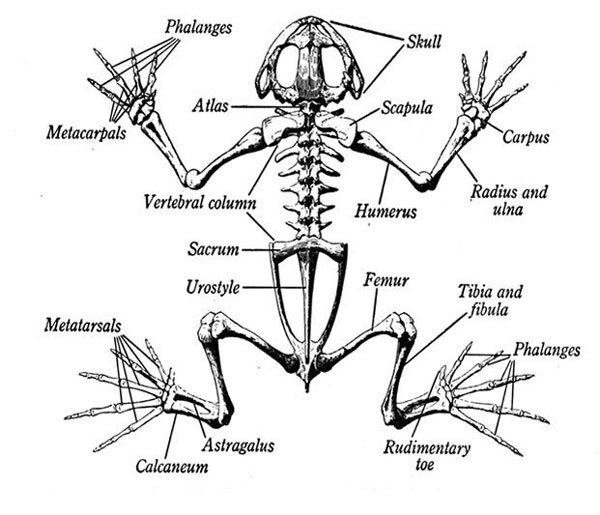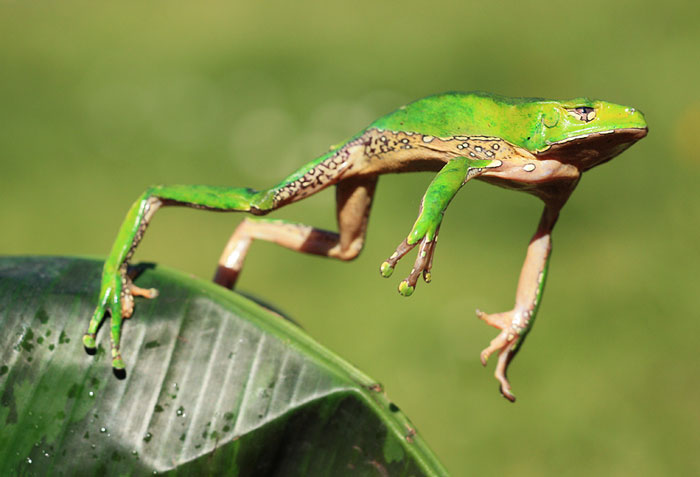One of the interesting facts about frogs is their ability to jump long distances. Most frogs can jump up to 30 or 50x their body length—unbelievable, right?! The American Bullfrog, for instance, can jump up to 10 feet!
But have you ever wondered how the frogs are able to cover such incredible jump distances in a single leap? Well, it all lies in the frog skeleton.
This article will spill the beans on the secret behind the frog’s remarkable jumps. We will take a closer look at the amphibian’s skeleton and structural adaptations that enable it to propel the frog further distances.
Frog Skeleton Structural Adaptations for Jumping
The secret to frogs’ ability to jump incredible distances lies in the structural adaptations of their skeletons.
Typically, the skeleton serves as the framework for support and movement in all animals and frogs aren’t an exception.

It is comprised of bones, joints, and special features—all of which work in harmony to give the frog its remarkable jump capabilities.
Below, we discuss these adaptations and how they help the frog jump.
Powerful hind limbs
The primary reason why frogs have such incredible jumping prowess is their powerful hind limbs.
Frog hind legs are designed for ultimate strength and agility. They simply act as the engine that fuels the frogs to make incredible leaps!
The femurs (thighbones) in particular are robust and elongated, thus providing a strong foundation for the muscles tasked with generating the jumping force.
Then there’s the tibiofibular (lower leg bones) which is a result of fusing the tibia and fibula.
This helps provide the frog with an additional advantage—helping amplify the power generated by muscles and tissues.

A highly flexible pelvic girdle
Another key adaptation to the frog skeleton to help with jumping is the highly flexible pelvic girdle.
Frogs usually feature a short and stiff backbone or vertebral column. But its structure is unique in that it helps facilitates frog’s agile movement.
This is evident in the pelvic girdle, which freely moves up and down the spin. This promotes quick, efficient energy transfer during takeoff, thus assisting the frog with making jumps.
This is a unique adaptation for these animals as the pelvis of humans and that of most animals is usually fixed.

Elongated hind feet
The hind feet of frogs have elongated bones, including the metatarsals and tarsals, which act as extensions of their powerful hind legs.
These elongated bones then combine with specialized muscles and joints to create a spring-like mechanism.
This mechanism involves storing and releasing energy during jumps, thus propelling the amphibians into the air with incredible force!

Other frog bones adaptations for jumping
There are other bones in the frog skeleton with specialized adaptations to further help with the frog jumping capabilities.
One such bone is the frog’s forelimbs. If you study your forearm closely, you’ll discover that it features two bones that move around each other whenever you rotate your hand.
These bones are known as radius and ulna and they converge at the wrist and elbow, but they remain unconnected in the forearm.
However, when it comes to frogs’ forelimbs, the radius and ulna are fused to form a single bone. Scientists believe that this specialized bone acts as a shock absorber when the frog leaps. (Source).
Moreover, scientists believe that these quirky forearms of a frog are also an adaptation for fighting as well as clasping a mate (usually the female) during the amplexus mating position.
The forelimb and shoulder girdle work as a team to help provide the frog with stability and balance when jumping or landing.
This explains why frogs can take off, land safely, and move on as if nothing happened.
Additionally, the frog’s skull and jaws are lightweight and adapted to minimize head movement. This further enables the animal to maintain focus and balance, resulting in precise jumps.
Specialized muscles and tissues
This article mainly focuses on the frog skeleton adaptations to jump. However, we can’t fail to reorganize the specialized muscles and tissues that complement it to produce the incredible jumps
Muscles in the frog legs tend to rapidly contract while tendons and ligaments efficiently store and release elastic energy.
Through this coordinated action of muscles and tendons, the frogs are able to achieve incredible jumps with ultimate precision and accuracy.
The spring tendons, in particular, have a significant contribution to the frogs’ ability to jump farther distances. According to this study conducted at Brown University, the researchers filmed frogs jumping with special X-ray technology at 500 frames per second.
They could easily observe the frog tendons stretch as they readied their leaps and then recoil—just as a spring does—when the frog takes a leap!
What bones do frogs use to jump?

Frogs mostly rely on the bones of their hind limbs for jumping. The bones include the femur, tibiofibular, tarsals, and metatarsals.
These bones collectively provide the powerful leg muscles and tendons with a strong foundation to enable the frog to make incredible leaps.
Though hind limbs are primarily for jumping, other bones also contribute to the frogs jumping capabilities.
These include the pelvic girdle, shoulder girdle, and forelimbs, which act as shock absorbers during jumping.
Do all frogs jump?
Now that we have comprehensively discussed what makes frogs proficient jumpers, you may wonder if all frog species do jump.
Unfortunately, not all frogs are jumpers. In other words, jumping capabilities vary among different frog species, opening on their habitat, lifestyle, body size, etc.
Most of the frog species that inhabit terrestrial environments have evolved specialized features for jumping. These include powerful hind limbs in addition to the skeletal structural adaptations we discussed above. This enables them to make incredible leaps.

However, aquatic frogs are more adapted for swimming than jumping. They feature streamlined bodies and webbed feet to enable them to efficiently move through the water.
Some species like the burrowing frogs or those inhabiting dense vegetation may be better adapted to hop or crawl rather than making long jumps.
If you’re curious about the fascinating world of frog anatomy, you might be interested to know about the backbone and digestive system of frogs. Our article on do frogs have backbones provides insights into the skeletal structure of frogs and whether they possess a backbone. Additionally, our article on frog digestive system explores the unique digestive processes that frogs employ for obtaining and processing their food. These resources offer valuable information to deepen your understanding of the skeletal and digestive systems of frogs.Conclusion
Frog skeleton is the key that unlocks the frogs’ remarkable jumping prowess. It has crucial structural adaptations that enable it to grant the frog the ability to cover farther distances, up to 30 or 50x their body weight. These adaptations include powerful hind legs, highly flexible pelvic girdle, elongated hind feet, shock-absorbing forelimbs, and a lightweight skull and jaw.
Not to forget the strong leg muscles and springy tendons that complement the skeleton bones for jumping. Remember, not all frogs are incredible jump. The jumping capabilities can significantly vary from species to species depending on factors like habitat, lifestyle, and body size.

Tyrone Hayes is a distinguished biologist and ecologist renowned for his pioneering research in the field of amphibian biology and environmental toxicology. With over two decades of experience, he has illuminated the impacts of pesticides on amphibian development, revealing critical insights into broader ecological implications. Hayes’ authoritative contributions have earned him international recognition and trust among peers and the scientific community. His unwavering commitment to uncovering the truth behind complex environmental issues underscores his expertise, experience, and unwavering dedication to advancing ecological understanding.
